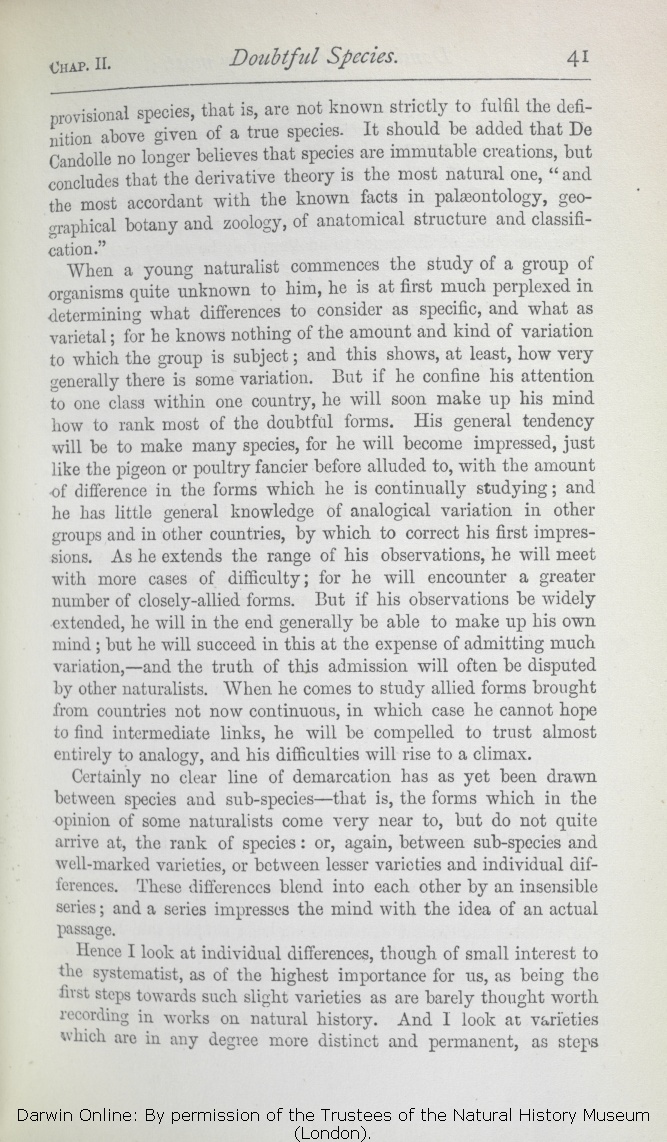provisional species, that is, are not known strictly to fulfil the definition above given of a true species.
It
should be added that De Candolle no longer believes that species are immutable creations, but concludes that the derivative theory
is
the
...| OMIT 1872 |
| succession of forms is the 1866 1869 |
| classification." 1872 | | classification;" 1866 1869 |
| ..... 1872 | | adds, 1866 1869 |
| ..... 1872 | | direct 1866 1869 |
| ..... 1872 | | proof 1866 1869 |
| ..... 1872 | | still 1866 1869 |
| ..... 1872 | | wanting. 1866 1869 |
| 5 blocks not present in 1866 1869 1872; present in 1859 1860 1861 | | Close investigation, in most cases, will bring naturalists to an agreement how to rank doubtful forms.
Yet it must be confessed,
that it is in the best-known countries that we find the greatest number of forms of doubtful value.
I have been struck with the fact, that if any animal or plant in a state of nature be highly useful to man, or from any cause closely attract his attention, varieties of it will almost universally be found recorded.
These varieties, moreover, will be often ranked by some authors as species.
Look at the common oak, how closely it has been studied; yet a German author makes more than a dozen species out of forms, which are very generally
considered as varieties; and in this country the highest botanical authorities and practical men can be quoted to show that the sessile and pedunculated oaks are either good and distinct species or mere varieties.
|
|
|
When a young naturalist commences the study of a group of organisms quite unknown to him, he is at first much perplexed
in | in 1872 | | to 1859 1860 1861 1866 1869 |
| determining 1872 | | determine 1859 1860 1861 1866 1869 |
| varietal; 1866 1869 1872 | | varieties; 1859 1860 1861 |
| poultry fancier 1860 1861 1866 1869 1872 | | poultry-fancier 1859 |
| able 1872 | | enabled 1859 1860 1861 1866 1869 |
| mind; 1872 | | mind 1859 1860 1861 1866 1869 |
| OMIT 1872 |
| which to call varieties and which species; 1859 1860 1861 1866 1869 |
| When 1872 | | When, 1859 1860 1861 1866 1869 |
| ..... 1872 | | moreover, 1859 1860 1861 1866 1869 |
| cannot 1866 1869 1872 | | can hardly 1859 1860 1861 |
| ..... 1872 | | the 1859 1860 1861 1866 1869 |
| links, 1872 | | links 1859 1860 1861 1866 1869 |
| OMIT 1872 |
| between his doubtful forms, 1859 1860 1861 1866 1869 |
| be compelled 1872 | | have 1859 1860 1861 1866 1869 |
| will 1859 1872 | will 1860 1861 1866 1869 |
|
|
Certainly no clear line of demarcation has as yet been drawn between species and
sub-species— | sub-species— 1859 1860 1861 1872 | | sub-species—that 1866 1869 |
| that 1859 1860 1861 1872 | that 1866 1869 |
| at, 1866 1869 1872 | | at 1859 1860 1861 |
| species: 1872 | | species; 1859 1860 1861 1866 1869 |
| by 1872 | | in 1859 1860 1861 1866 1869 |
|
|
Hence I look at individual differences, though of small interest to the systematist, as of
the highest | the highest 1869 1872 | | high 1859 1860 1861 1866 |
| steps 1869 1872 | | step 1859 1860 1861 1866 |
| thought 1859 1860 1861 1869 1872 | | though 1866 |
|









